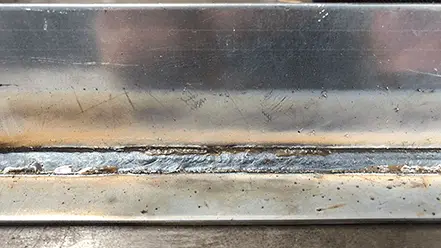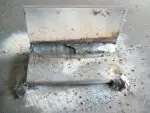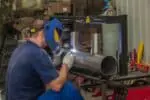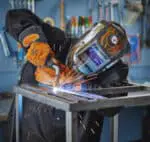Yes, zinc plated steel or galvanized steel can be welded. However, there are a few do’s and don’ts that need to be followed religiously to keep yourself safe during the process. Several precautionary safety measures come by default when welding any metal, so it is no exception with zinc-plated steel.
One of the most important things to keep in mind is that when zinc vaporizes during welding, it produces a poisonous fume, which when inhaled is extremely harmful or unsafe for our health. This is why welding galvanized steel is unpopular unless you adhere to the proper steps. Zinc has a lower melting point temperature compared to steel. To give you a more clear understanding of this comparison, let me put it this way – zinc starts to melt at a temperature of 450°C, whereas, steel starts to melt at 1400°C.
Zinc has a lower melting point temperature compared to steel. To give you a more clear understanding of this comparison, let me put it this way – zinc starts to melt at a temperature of 450°C, whereas, steel starts to melt at 1400°C.
So naturally, if you are going to weld zinc plated steel, the zinc will start to vaporize first and release the toxins which are dangerous for us. This article covers everything you need to know about zinc plated steel or galvanized steel and how to weld such metal.
What is the relation between zinc and steel?
Steel is prone to get damaged due to rust over time. Galvanizing or plating steel with zinc helps in preventing it from getting corroded, thereby, increasing its shelf-life.
The thick layer of zinc on steel shields it from exposure to moisture and the environment, which is what causes it to rust in the first place. So that is how the two are related.
You should also understand that there is a slight difference between zinc-plated steel and galvanized steel. While both serve the same purpose of protecting steel from corrosion, the main distinction lies in the density of the zinc coating on the metal.
When steel is coated with a thin layer of zinc, it is called zinc plating. This is done through electric current and by immersing the steel into a cold chemical solution of zinc.
Galvanized steel has a thicker layer of zinc, which is done by plunging the steel into a blazing molten solution of zinc. Since the latter gives a thicker zinc coating on steel, it provides better protection from rust.
Zinc-plated steel costs lesser and is easier to weld, compared to galvanized steel.
Nonetheless, both types of steel can be easily found in the market, and sometimes sellers sell them interchangeably, so you need to be cautious when buying steel depending on the kind you’re looking to buy.
Steps on how to weld galvanized steel or zinc-plated steel
Welding regular steel and zinc plated or galvanized steel is the same, the only difference you will find is in the preparation of welding the latter, as there are additional steps to be followed. Please follow the below steps systematically in order to have a successful welding project.
1.) The first and foremost step is to wear safety gear to keep yourself protected from sparks, heat, and toxic fumes. You need to wear an appropriate welding mask, welding gloves, a respirator, and an apron. Try and do the welding outside if possible to avoid inhaling the zinc fumes.
However, if this isn’t an option for you then make sure to keep the windows open at all times to let the fumes out of the room. You can also use a fume extractor for this or regular fans.
There is a high possibility for you to inhale the fumes despite all the safety gear, hence, taking the extra step can keep you protected further.
2.) You will need to start by cleaning or scraping the zinc coat from the steel in the area where you plan to do the welding. This can be done by grinding with a grinder or sanding using sandpaper. It is a great way to reduce the vaporization of toxic fumes caused by the melting of zinc.
3.) Once the zinc has been removed, you can commence the welding process. This step is like welding any other regular steel without the zinc coating. You can use a standard arc welder for this as it is by far the most undefeated method.
It is very versatile that generates a high-heat arc to melt the flux by using varying currents. TIG and MIG methods can be used too but you will just need to be more cautious while grinding the zinc coat.
4.) Make sure to adjust the pieces of steel accordingly so you don’t mess up your welding project and you get the desired results.
You can use welding clamps for small pieces of metal as it will help with getting the ideal seam. The welding surface has to be non-flammable, so be mindful of the area you are going to use for welding.
5.) Use a welding rod that is suitable for the size of the metal you will be welding. It should work well with your welder too. If you use a small rod it will be able to weld a small area compared to using a bigger rod, which will cover a larger area.
These are all the steps that you should follow while welding galvanized or zinc-plated steel.
https://youtu.be/nrMxZKDb5dI
What you should do post-welding of galvanized or zinc-plated steel?
As I mentioned earlier, zinc helps prevent the metal from rusting, and due to removing the zinc before welding the steel, this feature disappears that will make the steel prone to corrosion.
So, in order to fix this, you will have to re-galvanize the steel or paint it with paint that consists of zinc dust. The latter is a cheaper option, hence, you can opt for it.
What are the health hazards or concerns caused by inhaling zinc fumes?
It is essential for you to know the various health problems that you can face in case of accidentally inhaling the fumes of vaporized zinc.
1.) There is something called metal fume fever which is considered to be an industrial disease. This is a short-term effect on your health but still harmful. The symptoms include fever, nausea, shivers, headaches, thirst, and vomiting. This can last up to 48 hours once exposed to the fumes.
2.) Long-term health issues include lung cancer, brain cancer, and in some cases it also affects your nervous system. This is caused by the small lead content in the galvanized steel which when vaporized creates lead oxide fumes.
Now, you know how important it is to be in the proper safety gear and take all the necessary precautionary measures before you begin welding the galvanized steel or zinc plated steel.
A tried and tested method recommended by professional welders is to consume calcium supplements before attempting to weld galvanized steel. Calcium is known to help counterbalance the ingested zinc fumes. Some even advise drinking a glass of milk due to its calcium content.
Wrapping up
Welding zinc plated steel or galvanized steel is no different than welding any other type of steel, except for the additional steps that need to be taken before welding. As long as you are being careful and cautious of everything that you need to do, you will be safe and end up with a lucrative result.






